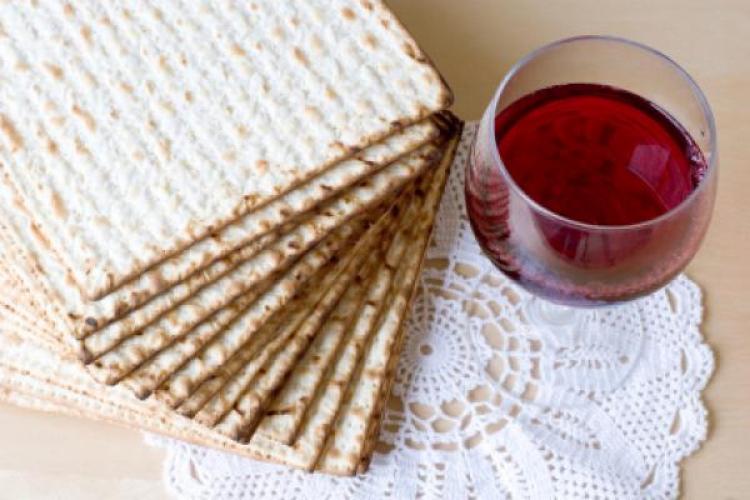
Best Comet of 2025?
C/2024 G3 (ATLAS) has already become very faintly visible to the naked eye for observers in the Southern Hemisphere.
Passover starts on the 15th day of Nisan in the Hebrew calendar and lasts for 7 or 8 days, usually in April. It celebrates the liberation of the Israelites from slavery and their exodus from Egypt, over 3000 years ago, as told in the Haggadah (Haggada).

Unleavened bread, Matzoh, commemorates the Israelites' hasty departure from Egypt.
©iStockphoto.com/dra_schwartz
During Passover, followers of the Jewish faith are forbidden to eat, drink, or own chametz or (chometz) – food that is made from grain (barley, oats, rye, spelt, or wheat) and water and has been allowed to rise. To avoid coming in contact with chametz, people thoroughly clean their homes and living spaces. Objects that cannot be cleaned or destroyed before the start of Passover are usually stored away or temporarily sold to someone who is not Jewish. They are then purchased back after the end of Passover.
In Israel, Passover lasts for 7 days. However, in other countries, people may observe it for 7 or 8 days. The first and last day of this period are particularly important. People recite special blessings or prayers, visit their synagogue, listen to readings from the Torah, and eat a ceremonial meal, which is centered around the Seder Plate and red wine or red grape juice.
None of the Passover days are federal holidays in Australia, Canada, the United Kingdom, or the United States. However, many Jewish businesses and organizations close or have limited opening hours during this period. Jewish people may also choose to take some of their annual leave at this time.
The story about the origin of Passover is also the story of the life of Moses. For a time, the Israelites lived in peace and prosperity amongst the Egyptians until a new Pharaoh saw them as a threat to his power. He enslaved them and ordered all their sons to be killed at birth to prevent a new leader from arising.
According to the story, one mother was able to conceal the birth of her son, Moses. When she could no longer hide him, she hid him amongst the bulrushes. The Pharaoh's daughter noticed the baby and decided to adopt him. She sent Moses' sister to find an Israelite woman to nurse him, so he was reunited with his mother. When Moses was older, he moved into the palace where the Pharaoh's daughter raised him as her own son.
As a young man, Moses noticed the suffering of the Israelites and his actions in retaliation forced him to leave Egypt to become a shepherd. God appeared to Moses one day in the form of a burning bush and commanded him to return to Egypt to lead his people into freedom with the help of his brother Aaron. Although Moses and Aaron repeatedly begged the Pharaoh to free the children of Israel, they were not successful. As punishment, God inflicted 10 plagues on the Egyptians. After the 10th plague, in which all first-born children of the Egyptians died, the Pharaoh agreed to free all Israelites and to allow them to leave Egypt with their possessions. As they had to leave in a hurry, they did not have time to allow bread to rise, so they baked unleavened bread, known as matzoh (plural matzah), for the journey.
Passover is historically related to the Christian Easter and the Islamic Day of Ashura.
Many aspects of Passover have a symbolic meaning. Cleaning the house to remove chametz, using a candle, a feather, a wooden spoon, and a paper bag, symbolizes the removal of egotism and spiritual coarseness from life. The matzoh represents the haste in which the Israelites left Egypt, and the red wine or grape juice represents the blood of sacrifices and male circumcision. Special kitchen utensils and the Seder Plates are used in the special Passover meals.
The Seder Plate consists of 3 matzoh piled on top of each other on a plate or clean cloth, which are then covered with another plate or cloth. Next, small pieces of symbolic foods are then placed on top. The foods are: zeroa , a roasted shank bone or chicken neck; beitzah, a hard boiled egg; maror, freshly grated horseradish or the stalks of romaine lettuce; charoset, a mixture of chopped apples, nuts, and wine; karpas, a non-bitter vegetable, such as an onion or a boiled potato; and chazeret, more horseradish or romaine lettuce. A dish of salt water and wine accompanies the Seder Plate. Each item on the plate represent a different aspect of the Passover story and they are eaten in a particular order and in specific combinations during the ceremonial meal.
In the Jewish diaspora—Jewish communities outside of Israel—an extra day is usually added to religious observances, with the exception of Yom Kippur, which lasts only one day worldwide, and Rosh Hashana, which is celebrated over two days in both Israel and the diaspora.
This custom has its roots in ancient times when the beginning of the months in the Jewish calendar still relied on the sighting of the crescent Moon following a New Moon.
The beginning of a new month was determined by the Sanhedrin, the supreme court of ancient Israel in Jerusalem. Once the date was published, messengers were dispatched to spread the news among Jews living abroad. Since this process took some time, it was decreed that Jews outside of ancient Israel were to observe every holiday for 2 days to make sure that the rules and customs applicable to each holiday were observed on the proper date. This rule is still observed today.

C/2024 G3 (ATLAS) has already become very faintly visible to the naked eye for observers in the Southern Hemisphere.

How does the 12-hour clock system work? Is midnight 12 am or 12 pm?

Why do many countries set the clocks back and forth an hour twice a year?

Why are there 12 months? How long are they, and what do the month names mean?